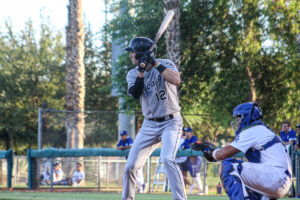In-person reports – Fulmer and three relievers with Charlotte
Rob Young and I covered the Charlotte Knights for games on May 6th and 7th, getting a chance to watch a number of important White Sox prospects and get some video. We also did interviews, which will go up later.
In this article, we empty the notebook and provide some videos on the pitchers we saw who are not named Reynaldo Lopez (Rob will cover him in a seperate article). This includes starter Carson Fulmer, as well as four relievers who all have a shot at joining the White Sox in 2017.
Carson Fulmer
We have written extensively on Fulmer, so this is more of an update than a get-to-know-you piece. The team’s 2015 1st round pick has worked through some mechanical issues in his time in the minors thus far, and even saw the majors briefly last year in a rushed promotion. Now settling down into a rotation spot in AAA, Fulmer looks likely to be the next call-up when the White Sox need a starter.
Let’s start with the mechanics. Carson’s delivery is still high effort with explosive arm action, and he still has the head whack to the first base side. The violence of both has diminished somewhat, but both are still readily seen. His intense personality also seems a little more subdued on the mound. Here’s an open side video of a few pitches from Fulmer to give you an idea…
Sure enough, Charlotte Pitching Coach Steve McCatty talked about slowing down Fulmer’s delivery a bit and calming it as a goal:
The thing that worked on with Carson last year, I’ve talked to Dot (Richard Dotson) a lot about it, is he is a fairly energetic guy and he likes to get going quick and has to learn how to stay back and not rush through his delivery.
In the contest I watched, Fulmer went six pretty strong frames, allowing just three hits and a walk, striking out four. He didn’t give up much hard contact, beyond a Mel Rojas Jr home run in the second and a line drive single off his hip in the 3rd. After the hip hit he struck out the next batter and then induced a double play.
In terms of stuff, Fulmer’s primary fastball was running generally 92-94, touching 95 at least twice, and showed his usual run and some sink. He held that velocity range throughout his six innings, though perhaps was more often around 92 by the 6th. He also used a two-seamer to get some weak grounders, and a cutter or cut-slider in the mid to upper 80’s that was effective in getting whiffs and some weak contact. The cutter and 2-seamer are close enough in velo and have subtle movement so I may be mischaracterizing which was which in terms of his mix. The curveball was inconsistent, sometimes showing that big movement he’s capable of but other times rolling and staying up.
Here are a couple backstop videos of full at-bats to watch, including the one that ended with a liner off his body…
-Full at bat versus Sean Kazmar, ends in fly-out…
-Full at bat versus Blake Lalli, ends in a liner off Fulmer’s hip…
Fulmer looks ready to start in the majors. The fastball and curveball that have been billed for plus potential will likely settle a little lower, but both still show as effective with potential for above average. The cutter/slider pitch he throws works well too, his 2-seamer gave a different look than the bigger heater, and the change is a work-in-progress. Endurance doesn’t seem to be an issue, and concerns over his health due to that deliver thus far have been unfounded. He’s still got room to improve, and there’s every reason to believe he will. But he can work in a major league rotation at the back end now, with potential to be more – and soon.
Zack Burdi
When we saw Zack Burdi make his High-A debut last season, shortly after he was drafted, we saw a seriously high octane fastball (97-102), a slider with big horizontal movement around 88-90, and an inconsistent change-up in a similar band. His command was pretty lacking, though the stuff was so impressive he was still making most hitters look silly.
Less than a year later and now in AAA, Burdi has substantially improved that command. In this viewing, his fastball sat 99-100, hitting 101 twice according to Trackman. His slider was in the 87-92 range and showed that big bend. Most importantly, he spent much more time in and around the strike zone than in our look last year. And according to the locals, this was the worst his command had looked in the last few weeks. With his stuff he doesn’t have to have pinpoint location, so if he’s made substantial strides on that, he’s ready to not only join a major league bullpen today, he’s likely to be very good.
Sadly we didn’t get video from this game, but if you want the general flavor, here’s an at-bat from last summer where he went 101-102-101 with the heater:
Brian Clark
The first reliever I saw on the 7th was lefty Brian Clark. He’s moved up the ladder fairly quickly with good results both starting and relieving, and just turned 24. He’s not a LOOGY candidate – the delivery is pretty close to overhand and doesn’t show exaggerated splits. The stuff is an odd aHe has a main fastball that runs 89 to 91 with substantial sink (he’s been reportedly higher previously), and he can locate it pretty easily. The slider is a low 80’s offering that doesn’t show much special in movement, but he’s very good at hiding it so that it looks just like the fastball out of his hand. He’s also got a change of pace that comes in around 80.
Physically he’s filled out, with a strong build. His delivery is easy, and all of his pitches come with no change in delivery. Here’s a video of him inducing a strikeout from former Knight, Matt Tuiasosopo…
The stuff is marginal, but he works the edges and changes eye level to be effective. The pitches are all heavy and he doesn’t give anything away. His likely role in the majors would be a middle or long reliever, not as a specialist. It’s hard to say if it will play in the big leagues, and he’s not had enough time in AAA yet to give a better picture. He’d benefit from staying there for most of 2017, and if he can keep getting hitters out, he might be a bullpen call-up candidate.
Brad Goldberg
Brad has an unusual development history. He moved quick at first as a reliever, went in and out of a starting role where he struggled, lost a bunch of weight, and suddenly increased his fastball velocity by about five ticks on the gun.
Today? Goldberg throws a fastball in the 95 to 98 range, and touched 99 once in the outing I witnessed. It has some fade to his arm side. He’s also got a pitch in the low 90’s that looks like maybe a cutter, but I’d need to investigate more – in any case he pitches it with the same delivery as the 4-seamer and it works. His upper 80’s slider isn’t special, but it works as a pace changer and he an
The first thing you’ll see from Goldberg though, is that he does what I can only describe as a little dance before he throws. He sets his front foot three different times, in different places, before he delivers. He’s got good athleticism and looked good fielding his position in my look. Added to the 40-man roster prior to the season, Goldberg has a good chance to see Chicago at some point during the season.
Want to know right away when we publish a new article? Type your email address in the box on the right-side bar (or at the bottom, if on a mobile device) and click the “create subscription” button. Our list is completely spam free, and you can opt out at any time.






